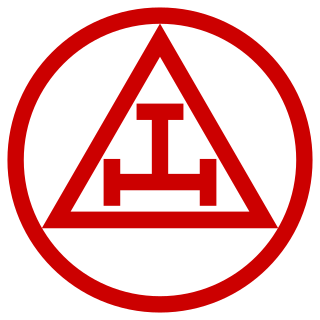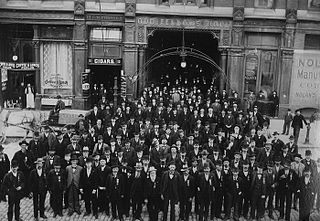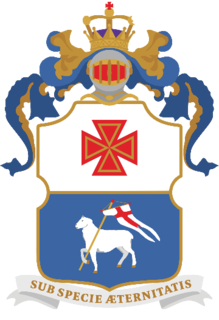The York Rite, sometimes referred to as the American Rite, since it is named for, but not practiced in York, England, is one of several Rites of Freemasonry. A Rite is a series of progressive degrees that are conferred by various Masonic organizations or bodies, each of which operates under the control of its own central authority. The York Rite specifically is a collection of separate Masonic Bodies and associated Degrees that would otherwise operate independently. The three primary bodies in the York Rite are the Chapter of Royal Arch Masons, Council of Royal & Select Masters or Council of Cryptic Masons, and the Commandery of Knights Templar, each of which are governed independently but are all considered to be a part of the York Rite. There are also other organizations that are considered to be directly associated with the York Rite, or require York Rite membership to join such as the York Rite Sovereign College but in general the York Rite is considered to be made up of the aforementioned three. The Rite's name is derived from the city of York, where, according to one Masonic legend, the first meetings of Masons in England took place.

The Independent Order of Odd Fellows (IOOF) is a non-political and non-sectarian international fraternal order of Odd Fellowship. It was founded in 1819 by Thomas Wildey in Baltimore, Maryland, United States. Evolving from the Order of Odd Fellows founded in England during the 1700s, the IOOF was originally chartered by the Independent Order of Oddfellows Manchester Unity in England but has operated as an independent organization since 1842, although it maintains an inter-fraternal relationship with the English Order. The order is also known as the Triple Link Fraternity, referring to the order's "Triple Links" symbol, alluding to its motto "Friendship, Love and Truth".

The Swedish Rite is a variation or Rite of Freemasonry that is common in Scandinavian countries and to a limited extent in Germany. It is different from other branches of Freemasonry in that, rather than having the three self-contained foundation degrees and seemingly-endless side degrees and appendant bodies, it has an integrated system with ten degrees. It is also different in that, rather than moving through the offices or 'chairs', progress in the Swedish Rite is based on moving through the ten degrees. A fundamental difference is the Swedish Rite's position on religious affiliation: Masonry as recognized by the United Grand Lodge of England requires a belief in God, but accepts candidates of any theistic religion, whereas Swedish Masonry is specifically Christian, and requires a Christian trinitarian belief in all its members. Nonetheless, the main Swedish Rite constitutions are all recognised as regular by the United Grand Lodge of England, and stand in full amity.

Odd Fellows is an international fraternity consisting of lodges first documented in 1730 in London. The first known lodge was called Loyal Aristarcus Lodge No. 9, suggesting there were earlier ones in the 18th century. Notwithstanding, convivial meetings were held "in much revelry and, often as not, the calling of the Watch to restore order." Names of several British pubs today suggest past Odd Fellows affiliations. In the mid-18th century, following the Jacobite risings, the fraternity split into the rivaling Order of Patriotic Oddfellows in southern England, favouring William III of England, and the Ancient Order of Oddfellows in northern England and Scotland, favouring the House of Stuart.

The Independent Order of Oddfellows Manchester Unity Friendly Society Limited, also called the Manchester Unity of Oddfellows; trading as The Oddfellows, is a fraternal order founded in Manchester in 1810.

The Daughters of Rebekah, also known as the Rebekahs and the International Association of Rebekah Assemblies, is an international service-oriented organization and a branch of the Independent Order of Odd Fellows. It was initially designed as the female auxiliary of the IOOF, but now allows both female and male members.
The Royal Order of Scotland is an appendant order within the structures of Freemasonry. Membership is an honour extended to Freemasons by invitation. The Grand Lodge of the Royal Order of Scotland is headquartered in Edinburgh, with a total of 88 subordinate Provincial Grand Lodges; of these, the greatest concentration is in the British Isles, with the rest located in countries around the world.

There are many organisations and orders which form part of the widespread fraternity of Freemasonry, each having its own structure and terminology. Collectively these may be referred to as Masonic bodies, Masonic orders or appendant bodies of Freemasonry.
Ye Antient Order of Noble Corks or Ancient & Honourable Societas Korcorum Magnae Britanniae , universally known, informally, as The Cork, is an informal degree allied to Freemasonry. It is described as a "fun" degree, with charitable fund raising as a principal aim.
Odd Fellows Hall, Independent Order of Odd Fellows Building, IOOF Building, Odd Fellows Lodge and variations are buildings for a chapter of the Independent Order of Odd Fellows fraternal organization.

The Royal Arch is a degree of Freemasonry. The Royal Arch is present in all main masonic systems, though in some it is worked as part of Craft ('mainstream') Freemasonry, and in others in an appendant ('additional') order. Royal Arch Masons meet as a Chapter; in the Supreme Order of the Holy Royal Arch as practised in the British Isles, much of Europe and the Commonwealth, Chapters confer the single degree of Royal Arch Mason.

The Ancient Order of United Workmen (AOUW) was a fraternal organization in the United States and Canada, providing mutual social and financial support after the American Civil War. It was the first of the "fraternal benefit societies", organizations that would offer insurance as well as sickness, accident, death and burial policies.

The Red Cross of Constantine, or more formally the Masonic and Military Order of the Red Cross of Constantine and the Appendant Orders of the Holy Sepulchre and of St John the Evangelist, is a Christian fraternal order of Freemasonry. Candidates for the order must already be members of Craft Freemasonry (lodge) and Royal Arch Freemasonry (chapter); they must also be members of the Christian religion, and proclaim their belief in the Christian doctrine of the Holy Trinity.
Amos or AMOS may refer to:
The Grand United Order of Odd Fellows, American Jurisdiction is a jurisdiction of the Grand United Order of Oddfellows in the United States, Jamaica, Canada, South America, and other locations. Since its founding in 1843, its membership has principally included African Americans, due to black people being discriminated against, as was the norm in fraternal orders in America during the 1700—1800s.

The Ancient Mystic Order of Samaritans (AMOS) is an unofficial appendant body to the Independent Order of Odd Fellows in the United States and Canada. It is recognized as the "playground for Odd Fellowship" by the Sovereign Grand Lodge of the Independent Order of Odd Fellows and is known for engaging in public and private hijinks and spectacle, all in the name of good, clean fun. AMOS is open to male Odd Fellows in good standing over the age of 18 but has a close relationship with Ladies of the Orient ("LOTO"), which is only open to women. The two organizations typically meet at the same time and share in social events with each other. Like many other primarily social appendant bodies to fraternal organizations, the rituals and initiations of AMOS have a Middle-Eastern theme and the official regalia is a fez.
The Ladies of the Orient (L.O.T.O.) is a women's fraternal organization in the United States and Canada which had its origins as an appendant body to the Rebekahs. The first unit, Pioneer Zuanna No. 1 was founded in Syracuse, New York in 1915 by Emily Voorheis for the purpose of having a group dedicated to recreation and amusement as a pleasant diversion from the serious charitable work done by other groups to which the ladies already belonged. It was first incorporated in New York in 1921 under the name "Supreme Royal Zuanna of the Mystic Degrees of Persecution and Purification Ladies of the Orient of United States and Canada". While it has a close relationship with the Odd Fellows appendant body known as the Ancient Mystic Order of Samaritans, it is not a true women’s auxiliary, but rather an independent organization founded entirely by women and requiring no affiliation with its men’s counterpart. Local units of LOTO are referred to as "zuannas" and are presided over by a "Great Ashayhi." The basic regalia of the group is a white fez with a "Z" inside a triangle and crescent bearing a yellow tassel, though there are more advanced fez and tassel colors for higher-ranked members, such as a white fez with a purple tassel for Past Ashayhis. As with AMOS, the group has a particular charitable focus on Cognitive disabilities.

The Icelandic Order of Freemasons, in English also known as the Grand Lodge of Iceland, is the governing body of regular Freemasonry in Iceland.












